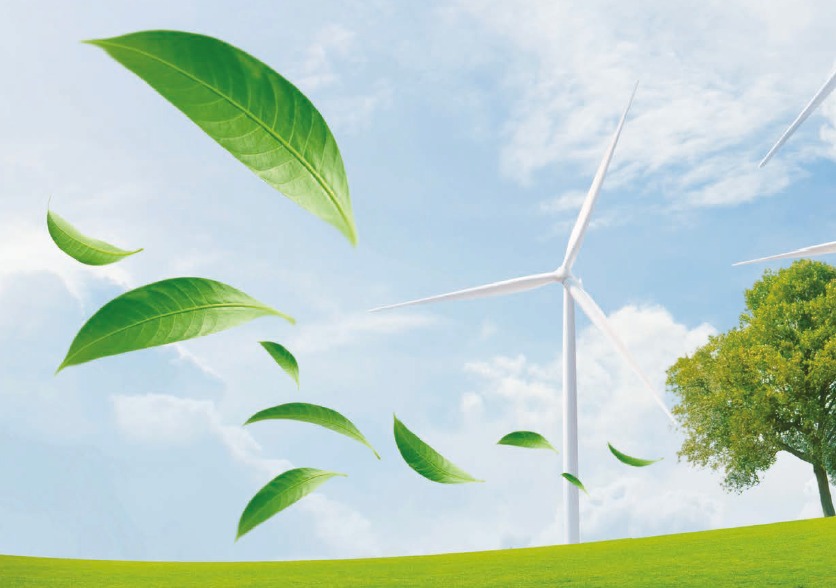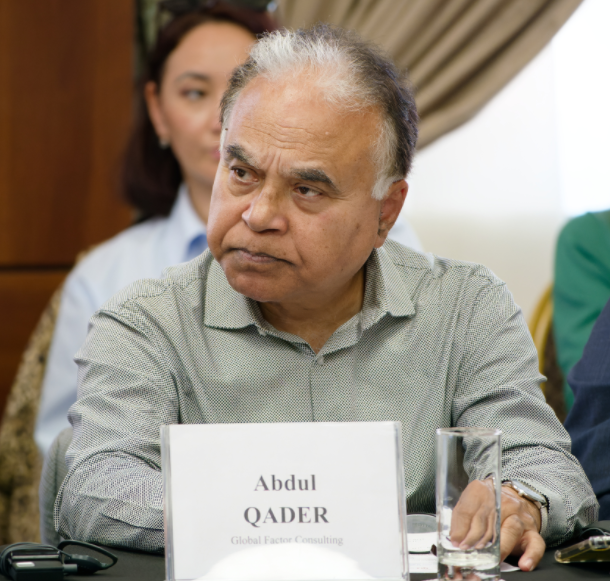Environmental policy29.05.2024
Development of renewable energy sources as a key instrument for decarbonization of industry in Kazakhstan

Global Factor, an international team of experts dedicated to offering innovative solutions for global green transformation, recently conducted a visit to Kazakhstan. During their visit, the experts engaged in a series of meetings with representatives from both the public sector and private enterprises. Their objective was to assess the influence of the climate agenda on the Kazakh economy and to gauge the country's preparedness for the energy transition.
In an exclusive interview with Qazaq Green, the specialists from Global Factor shared their insights into low-carbon development and elaborated on the outcomes of their endeavors in Kazakhstan.
QG: What results does GIZ expect from the dialogue between industry and decision makers? What specific questions will be addressed in the sectoral study on industry needs during the decarbonization period?

Craig Menzies, Head of the Department of Energy, Global Factor Сonsulting:
The dialog between industry and decision makers in Kazakhstan is expected to support the development of processes, methodologies and instruments for long-term decarbonization planning. It will develop products that show industrial actors and market players that decarbonization interventions are economically viable and attractive. It will propose solutions that shield those companies from key risks within an international context of rapid decarbonization.
This is necessary for the integration of climate and economic transformation targets with significant potential for sustainable and climate neutral development. Kazakhstani industry (and the metal production sector) needs to be aligned with the country’s forthcoming updated NDC. Kazakhstan is aiming to become climate neutral by 2060.
The sectoral study will deal with topics such as the use of renewable energy sources in the industry and the options for decarbonization for the players in the metallurgic sector.
The study will provide pathways for metallurgy sector decarbonization without decreasing Kazakh companies’ competitiveness. It will look at aspects such as the effect that CBAM (the Carbon Border Adjustment Mechanism) introduced in the EU will have on metallurgical sector companies’ exports, for example.
The project will also consult widely with sectoral actors and stakeholders, and will integrate their needs as regards decarbonization interventions, and will assess the barriers, concerns, and ways to overcome these.
QG: Why is the transition to green energy so important for Kazakhstan's industry and what specific decisions do the country's authorities need to take to decarbonize industries?

Alex Bologa, Expert, Global Factor Consulting:
The Government of the Republic of Kazakhstan has set a goal of achieving the share of renewable energy sources up to 15% in the electricity generation structure by 2030. Potentially, by achieving this goal, the amount of greenhouse gases will be reduced by almost 8 million tons.
The main problem of the energy sector in Kazakhstan is that a large percentage of the installed generation capacity consists of morally and physically obsolete coal power plants dating back to the Soviet era. For the production of electricity from renewable energy sources, the country has “raw materials”: wind and solar radiation as natural energy carriers. But there is no mass production of means of generating electricity from them. In order for wind energy and renewable energy sources to become a competitively dominant sector of the economy, not only conditions are needed in the form of raw materials and sales markets, but also industries related to the generation, transport and sale of electricity, many enterprises united in clusters and creating an added value chain from design to final product and even environmentally friendly processing of exhausted RES elements. With this approach, the price of components for renewable energy facilities can be reduced due to the effect of scaling production.
To develop the renewable energy industry in Kazakhstan, it is necessary to solve a set of problems:
1. Creation of regulatory mechanisms regarding the connection of new renewable energy facilities to the energy system and the order of priority for the supply of electricity.
2. Development of the legislative framework and establishment of competitive tariffs for green electricity.
3. Solving the problem of balancing capacities for renewable energy sources will accelerate the growth of the share of renewable energy sources in the structure of electricity generation in Kazakhstan.
4. Development of own technologies and infrastructure for the production and maintenance of solar and wind generation facilities, as well as environmental disposal and processing of spent technical resources of renewable energy sources.
QG: Svevind Energy Group will build a green hydrogen plant in Kazakhstan. How does green hydrogen differ from other types of hydrogen and what challenges are predicted in terms of production, transportation and use?

Abdul Qader, Expert, Global Factor Consulting:
· Green hydrogen is produced by splitting the water molecule by the process of electrolysis, where the energy is supplied from renewable energy source of sun, or wind, or hydro, or biomass, or in combinations.
Hydrogen can also be produced by the synthesis of fossil fuels (coal, petroleum and natural gas).
· Grey Hydrogen is produced from fossil fuels, mainly from natural gas, using steam methane reforming (SMR) process. Currently this is the widely practised route.
· Brown Hydrogen is produced from coal gasification.
· If Grey or Brown hydrogen is accompanied by CCS, it is termed as Blue Hydrogen. But CCS is complex and expensive.
So, the Green Hydrogen is the only hydrogen which is completely emission free and the cleanest option for climate change measures.
However, green hydrogen has three challenges associated with its production process:
· It’s electrolysis process is an expensive process, which needs more R&D investment to reduce its cost,
· It requires a lot of power and water, and also
· Requires significant investment in renewable energy infrastructure, to produce the necessary electricity.
Hydrogen Transport
Green hydrogen is transported either in gaseous or liquid state or transforming it into ammonia or methanol or dimethyl ether using pipeline or tanks or ships.
The challenges for each transport option are given below:
1. Though liquid state can handle high volume, but it must be cooled to cryogenic temperatures (below −253°C) through a liquefaction process. Liquid tankers and ships need to be designed to handle liquid hydrogen at that temperature.
2. Maintaining hydrogen purity through transports
3. Hydrogen transportation and distribution pose specific issues in terms of safety. It’s wide flammability range, and the limited amount of energy needed to ignite it, all represent barriers to safe use.
4. With the development of hydrogen as an alternate fuel, a reliable and efficient hydrogen transportation network is essential.
Use of Hydrogen
The use of hydrogen is widespread. Apart from its traditional use in industrial processes such as in chemical manufacturing [like ammonia, methanol, and Dimethyl ether (DME) productions] and steel manufacturing, hydrogen-powered vehicles/fuel cell electric vehicles (FCEVs) are commercially available now and will increase in volume every year ahead. It can be used to generate electricity, power industry, and heat our homes and businesses.
The challenges in uses are:
1. Lack of hydrogen infrastructure and lack of its high-volume production prevent its extensive use,
2. Fuel cell-powered vehicles are expensive now, which requires R&D investment to lower the cost,
3. Implementing its widespread use in practice.
QG: Increasing adaptation to climate change is a priority for development and an economic necessity. What role can international cooperation and sharing of best practices play in helping Kazakhstan prioritize investments in climate change adaptation and ensure long-term economic resilience?

Dana Yermolyonok, Project Manager for CDCP III project in Kazakhstan:
Drawing on international best practices is crucial when implementing changes, especially in the context of climate adaptation. Many countries, including Kazakhstan, face similar challenges and are experimenting with various strategies to cope with climate change and its effects. There is much we can learn from their experiences. It's important to recognize that adaptation is a process rather than a static set of actions. We must clearly understand how the measures we adopt reduce climate-related risks.
As climate-related disasters become more frequent, the need to adapt to our changing environment becomes ever more apparent. Regular climate risk assessments should be integrated into standard and routine long-term planning processes, we need to consider the impacts of climate change on our plans and investments just the same way as we evaluate the impact of global economic situations or crises. To conclude, international cooperation and the sharing of best practices are vital in helping us collectively address future challenges.
International cooperation on adaptation is highly beneficial. It allows us to share best practices, navigate new approaches, and join forces.
One of the projects currently being implemented by GIZ is focused on the economic assessment of the impact of climate change on the economy of Kazakhstan. We have developed a macroeconomic model e3.kz, which allows us to see in which sectors the impact is maximum and where investments in adaptation measures will bring the greatest benefits.
It is important to remember that any decarbonization efforts should also take into account climate risks. If you want water-based renewable energy sources, do you correctly assess the long-term availability of water resources in the context of climate change? And what will the water situation be, for example, for cooling your thermal power plants? Perhaps it would be more profitable to build underground power lines somewhere that would not be damaged during storms? Long hot periods, so-called "heat waves", have a strong impact on energy demand - and there are many such examples.
In general, increasing the resilience of infrastructure - roads, pipelines - to climate change is one of the key issues globally today. Long-term climate forecasts show that there will be more and more extreme weather events.
International collaboration on adaptation is essential. It enables the exchange of best practices, exploration of new methods, and a collective effort to address issues.
One of the current GIZ projects focuses on economic modeling and assessments of the impacts of climate change on Kazakhstan's economy. The macroeconomic model, e3.kz, developed by this project, helps identify which sectors are most affected and where investments in adaptation measures are most beneficial.
It's also crucial to incorporate climate risks into any decarbonization efforts. For example, if you are considering hydro-based renewable energy sources, have you thoroughly evaluated the long-term availability of water resources in a changing climate? What about the water supply for cooling your thermal power plants? Perhaps underground power lines would be more effective and feasible in areas prone to storms? Extended periods of heat, known as “heat waves,” significantly influence energy demand – this is just one of many examples.
Ultimately, enhancing the resilience of infrastructure – such as roads and pipelines – to climate impacts is a critical global issue. Projections indicate that extreme weather events will become more frequent in the future. Global Factor is an international team of experts specializing in providing global, innovative, and sustainable solutions in areas such as climate change mitigation and adaptation, energy transition, green growth, climate finance, circular economy, and carbon markets.
Global Factor is an international team of experts specializing in providing global, innovative, and sustainable solutions in areas such as climate change mitigation and adaptation, energy transition, green growth, climate finance, circular economy, and carbon markets.
New additive strategy enhances efficiency of bifacial perovskite solar cells
India tests a totally-new source of energy
Kazakhstan and UAE reaffirm strategic energy partnership with 1 GW wind project
Solar becomes EU’s top power source for the first time ever
How decentralised renewables transform healthcare services in rural Zimbabwe
Chinese company to build solar and wind power plants in Kyrgyzstan
Seaturns raises €2.45 million to industrialize wave energy technology and accelerate global rollout
Trump signs executive order to end subsidies for wind and solar energy
Uzbekistan's solar and wind power plants generate 5 Billion kWh since beginning of the year
Green Corridor Alliance JV registered in Baku to promote green energy development in Central Asia and the South Caucasus
In the EU renewable energy supply grew by 3.4% in 2024
IRENA accepting renewable energy project proposals in Central Asia until August 15
Astana to host Electronica Expo Kazakhstan Electronics Exhibition
WB gives rundown of Azerbaijan's green energy grid volume prospects
US solar sets new records as renewables nearly match natural gas – EIA
‘Wings’ on poles: Bill Gates-backed breakthrough wind turbine facility breaks ground
Perovskite tandem solar cell achieves new efficiency record
Kazakhstan and China endorse draft SCO joint statement on sustainable energy development
Innovative research on organic solar cells for space applications
Kazakhstan and Uzbekistan drive green energy progress in Central Asia











